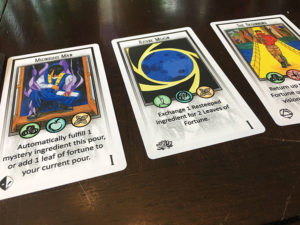Note: This preview uses pre-release components and rules. What you see here may be different from the final, published game. This post was a paid preview, you can find out more information here.
 To Teenaged Alex, a ‘cup of tea’ meant a Lipton or Bigelow bag dunked in some hot water for an indeterminate amount of time, with a healthy dose of sweetener. As I grew older, a little more well-rounded, and married, I realized that teas came in a wide variety of flavors, varieties, and colors. Walking with my wife into the tea store (yes, tea store!), I was shocked at just how many different varieties were available, with combinations I would not even dream of. Jasmine pearls, red teas, white teas, all with different herb and fruit varieties – positively overwhelming. I’ll just take a nice cup of tea, Earl Grey, hot, thank you very much.
To Teenaged Alex, a ‘cup of tea’ meant a Lipton or Bigelow bag dunked in some hot water for an indeterminate amount of time, with a healthy dose of sweetener. As I grew older, a little more well-rounded, and married, I realized that teas came in a wide variety of flavors, varieties, and colors. Walking with my wife into the tea store (yes, tea store!), I was shocked at just how many different varieties were available, with combinations I would not even dream of. Jasmine pearls, red teas, white teas, all with different herb and fruit varieties – positively overwhelming. I’ll just take a nice cup of tea, Earl Grey, hot, thank you very much.
Steepseers, the upcoming title from KinSoul Studios, puts you in the role of an oracle who can use various brews of tea to trigger visions of the future. By collecting different combinations of ingredients and allying with various mystical spirits, you can make the population believe in the power of foresight through the haze of brewing tea.
Steepseers is a set collection and memory game for 2-4 players. Steepseers plays well at any player count.
Gameplay Overview:
Steepseers takes place over 10 rounds, with each player taking one turn during the round. On their turn, a player performs the following actions in sequence:
Attunement: Players select visions from a common tableau they wish to work towards fulfilling. Each vision has its own unique set of ingredients required to complete it, with more difficult (and higher-scoring) visions needing ingredients in higher numbers and of greater rarity. When the game begins, only one vision can be selected at a time; the number increases (up to three) as the game progresses. Players are not locked into their choices, as they can move their selections around as they like.

Gathering: There are four different dice in Steepseers, representing the flower, fruit, herb, and leaf ingredients needed to brew tea. At the start of the game, players select two of the four dice to roll, with that number increasing (to a maximum of all of the dice) in later rounds. Players are required to ‘lock’ at least one die roll per turn, providing them with opportunity to reroll if their needs are not met. When all the dice are locked, the player collects the ingredients as shown on the dice and places them in their bag of ingredients. Players are prohibited from looking in their ingredient bags, forcing them to recall the ingredients they have collected as the game has progressed.
Pouring: Hopefully players have good memory, because during this phase, players may pour out their ingredient bags in the hopes of fulfilling the vision cards they selected during attunement. If a player meets the required ingredients of a vision card, they collect that card, scoring points and enacting the effects of that particular vision. Players may fulfill multiple visions if they have both the ingredients and the attunement. Half of the unused ingredients are returned to a player’s possession, while the others are returned to the supply.
Each round brings a change to the game, whether it is the ability to attune to more visions, roll more dice, or refreshing the tableau of available visions. Also, as rounds progress, more difficult visions become available to fulfill.
Final scores in Steepseers are based on the difficulty level of the visions fulfilled, any game effects from completed vision cards, and by completing visions from sets (marked with the same icon). The player with the highest score is declared the winner!

Game Impressions:
On its face, Steepseers provides an easy entry point into the board game hobby, with an accessible theme and straightforward rules. Collecting resources to fulfill goals is evergreen in games, but that Steepseers provides for this through dice selection and rolling is a twist on a standard mechanic.

Where Steepseers stands apart is the memory aspect of keeping track of your collected ingredients. Unlike most games where all a players’ resources are laid out in front of them, Steepseers keeps that information hidden, forcing players to not only keep track of their own inventory, but to pay attention to their opponents’ choices just as intently. The recall requirement makes the game far more interesting than it would be without it.
Unlike other games that have limited time domains, our plays never had the feeling that a single choice early on would derail our entire game. In some games, if you make a bad choice early, you essentially pay for it for the rest of the game. Steepseers is very forgiving in the area of tactical mistakes, which adds to its accessibility and ease of play.
Final Thoughts:
Steepseers is a lightweight game that is great for playing with non-gamer friends and family, with memory aspect giving the weight to appeal to players in the hobby. It is a great game for groups looking to avoid the heavy depth of a Euro, and games that are easy to dive into with little fuss.
Steepseers is now in funding on Kickstarter, so head over to the campaign page if you’d like more information or to become a backer.
As always, we don’t post ratings for preview copies as the components and rules may change from the final game. Check back with us after the game is produced for a full review. This post was a paid preview, you can find out more information here.





















